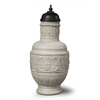Siegburg stoneware jug, attributed to Christian Knütgen
Global shipping available
- Origin
- Siegburg, Germany
- Period
- C. 1600
- Material
- Stoneware, pewter
- Height
- 25.5 cm
- Width
- 12 cm
- Depth
- 12 cm
- Literature
E. Hähnel, Siegburger Steinzeug, Keulen 1987, p. 270, cat. no. 767.
E. Klinge, Siegburger Steinzeug, Düsseldorf 1972, pp. 15 - 19, 28, 29, cat. no. 327.
Questions about this object?
Please use one of the contact options below:
Description
This richly decorated stoneware jug was made in Siegburg, and attributed to Christian Knütgen. The cream-coloured, unglazed stoneware is characteristic of stoneware production in Siegburg, which was exported on a large scale via the Hanseatic League. The jug is decorated in relief with on the applied symmetrical main frieze a bearded mascaron with feathers, flanked by two horns of plenty and floral motifs, squirrels, birds, butterflies and other animals. On the sides are two flower vases. On the neck frieze is an applied motif of oval medallions with mascarons and symmetrical floral scrollwork. The shoulders of the jug are decorated with fine carving. Between the foot and the main frieze are stamped flower shapes, with carved relief. The round handle is tapered towards the bottom. The jug is fitted with a pewter lid with two spheres on the thumb rest.
Stoneware, made tough and watertight by high-temperature firing, was used from the 13th century onwards as drinking vessels and for storing liquids. Around 1500, stoneware produced primarily in Cologne, Frechen, Siegburg, Raeren, and Westerwald, became fashionable for decorating with, among other things, applied reliefs. The different regions developed their own styles, although some mutual influence can be demonstrated. The refined reliefs, which were as it were pasted onto the object after a first drying, were often inspired by contemporary engravings. Many of the motifs can be traced back to the work of Virgil Solis, Heinrich Aldergrever and Theodor de Bry. In the third part of the sixteenth century, new decoration techniques, such as stamping and incised motifs, were introduced. In this period, the tapering end of the handle also became common. The stoneware jug is attributed to ( the workshop of ) Christian Knütgen (1559 - 1605) based on the refined decorations and carving. For a jug by Christian Knütgen with identical neck frieze and similar motifs, see cat. no. 32 in Klinge (1972) and cat no. 767 in Hähnel (1987). Knütgen was one of the most important makers of Siegburg stoneware, producing elegant jugs, the reliefs mostly inspired by the engravings of Theodor de Bry.









